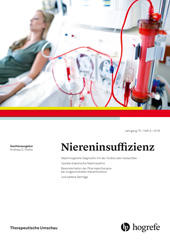Hämodialyse und Peritonealdialyse: Was Nicht-Nephrologen wissen sollten
Abstract
Zusammenfassung. Hämodialyse und Peritonealdialyse stehen zur Lebensverlängerung von zunehmend älteren und polymorbiden Patienten mit chronischer Niereninsuffizienz zur Verfügung. Bei qualifizierten Patienten dient die Dialyse als Überbrückung bis zur Nierentransplantation. Hämodialyse und Peritonealdialyse sind aufwändige und belastende Therapien. Sie ersetzen die Nierenfunktion suboptimal und schränken die Lebensqualität ein. Die Wahl der Nierenersatztherapie soll patientenzentriert, nach ausführlicher Information in einem multidisziplinären Team und gemeinsam erfolgen. Bei der Wahl der Dialysemethode spielt der Wunsch des Patienten die zentrale Rolle. Medizinische Kriterien können die Wahl beschränken. Die Hämodialyse ist eine sehr effiziente, intermittierend durchgeführte Nierenersatztherapie und findet in der Regel an einem Dialysezentrum statt. Die Peritonealdialyse ist eine sanftere Therapie und wird vom Patienten zu Hause selbstständig oder mit Unterstützung durchgeführt. Peritonealdialyse und Hämodialyse sind bezüglich Patientenüberleben vergleichbar. Im Langzeitverlauf wird häufiger von einer Peritonealdialyse auf Hämodialyse gewechselt als umgekehrt. Die Lebensqualität wird in der Regel an der Peritonealdialyse als höher eingeschätzt als bei der Hämodialyse. Eine Dialysetherapie soll nicht zu früh gestartet werden. Ausser bei sehr stark eingeschränkter Nierenfunktion (GFR < 6 ml / Min. / 1.73 m2) kann mit dem Dialysebeginn zugewartet werden, solange der Patient keine urämischen Symptome entwickelt, die Neigung zur Hypervolämie kontrollierbar ist und keine gefährdenden Laborwerte vorliegen. Dialysepatienten sind chronisch krank, oft hochgradig polymorbid und psychosozial belastet. Nur ein multidisziplinäres Betreuungsteam kann den Bedürfnissen dieser Patienten gerecht werden. Der Grundversorger spielt auch bei der Betreuung von Dialysepatienten eine wichtige Rolle. Besonders relevant sind die frühzeitige Identifikation von Patienten mit Risikofaktoren für oder in frühem Stadium einer Nephropathie und die rechtzeitige Zuweisung bei Auftreten von sekundären Komplikationen und im Hinblick auf die Vorbereitung der Nierenersatztherapie.
Abstract. Haemodialysis and peritoneal dialysis are widely available procedures, which prolong life for increasingly old and polymorbid patients with end-stage renal disease. In selected patients dialysis serves a bridging purpose until renal transplantation, in older and frail patients dialysis is performed until the end of life. Both dialysis modalities are cumbersome, wearying and costly treatments. They substitute renal function suboptimally and are associated with reduced quality of life. The choice of renal replacement therapy should be patient-centred and include extensive information by a multidisciplinary team. The preferences of the patient should dictate the choice of the dialysis method unless medical contraindications limit the treatment options. Haemodialysis is a very potent form of renal replacement therapy and it is perfomed intermittently, usually three times weekly in a dialysis facility. Peritoneal dialysis is a more gentle procedure and it is performed by the patient continuously at home, either independently or with support from carers. Patient survival with both dialysis methods is comparable. Technical problems occur less frequently with haemodialysis whereas quality of life is rated higher by peritoneal dialysis patients. Dialysis should not be started too early. Unless the glomerular filtration rate is very low (eGFR < 6 ml / min / 1.73 m2) the initiation of dialysis can be delayed as long as hypervolaemia is controlled, uraemic symtoms are not present and blood results are not menacing. Patients on dialysis are chronically ill, often highly polymorbid and psychosocially burdened. A multidisplinary team is necessary to meet their complex needs. The primary care physician plays an important role in the care of these patients. Recognition of risk factors or early stages of kidney disease combined with early referral to a nephrologist are important for the treatment of curable diseases, for the prevention of secondary complications of renal failure and for the optimal selection and preparation of renal replacement therapy.



